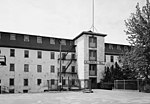Intercollegiate Athletic Arena
1995 establishments in Rhode IslandBuildings and structures in Providence, Rhode IslandCollege basketball venues in the United StatesIndoor arenas in Rhode IslandNortheastern United States sports venue stubs ... and 5 more
Providence, Rhode Island building and structure stubsRhode Island sport stubsSports venues completed in 1995Sports venues in Providence County, Rhode IslandSports venues in Rhode Island

Intercollegiate Athletic Arena is an 8,000 seat multi-purpose arena in Providence, Rhode Island. It was built in 1995. It is the home of the Rhode Island College Anchormen basketball teams.
Excerpt from the Wikipedia article Intercollegiate Athletic Arena (License: CC BY-SA 3.0, Authors, Images).Intercollegiate Athletic Arena
Mount Pleasant Avenue, Providence
Geographical coordinates (GPS) Address Phone number Website Nearby Places Show on map
Geographical coordinates (GPS)
| Latitude | Longitude |
|---|---|
| N 41.842777777778 ° | E -71.466944444444 ° |
Address
Rhode Island College
Mount Pleasant Avenue 600
02908 Providence
Rhode Island, United States
Open on Google Maps








